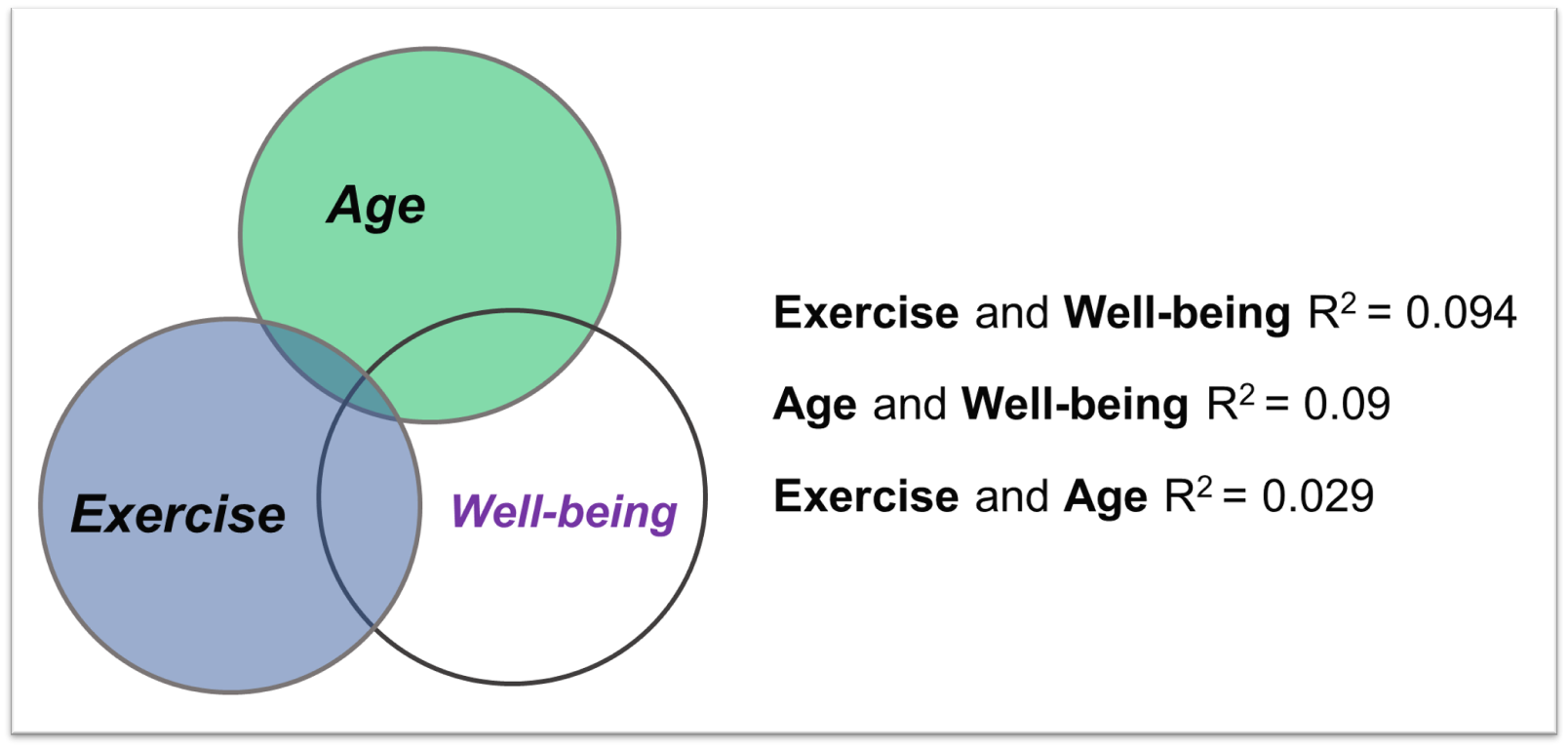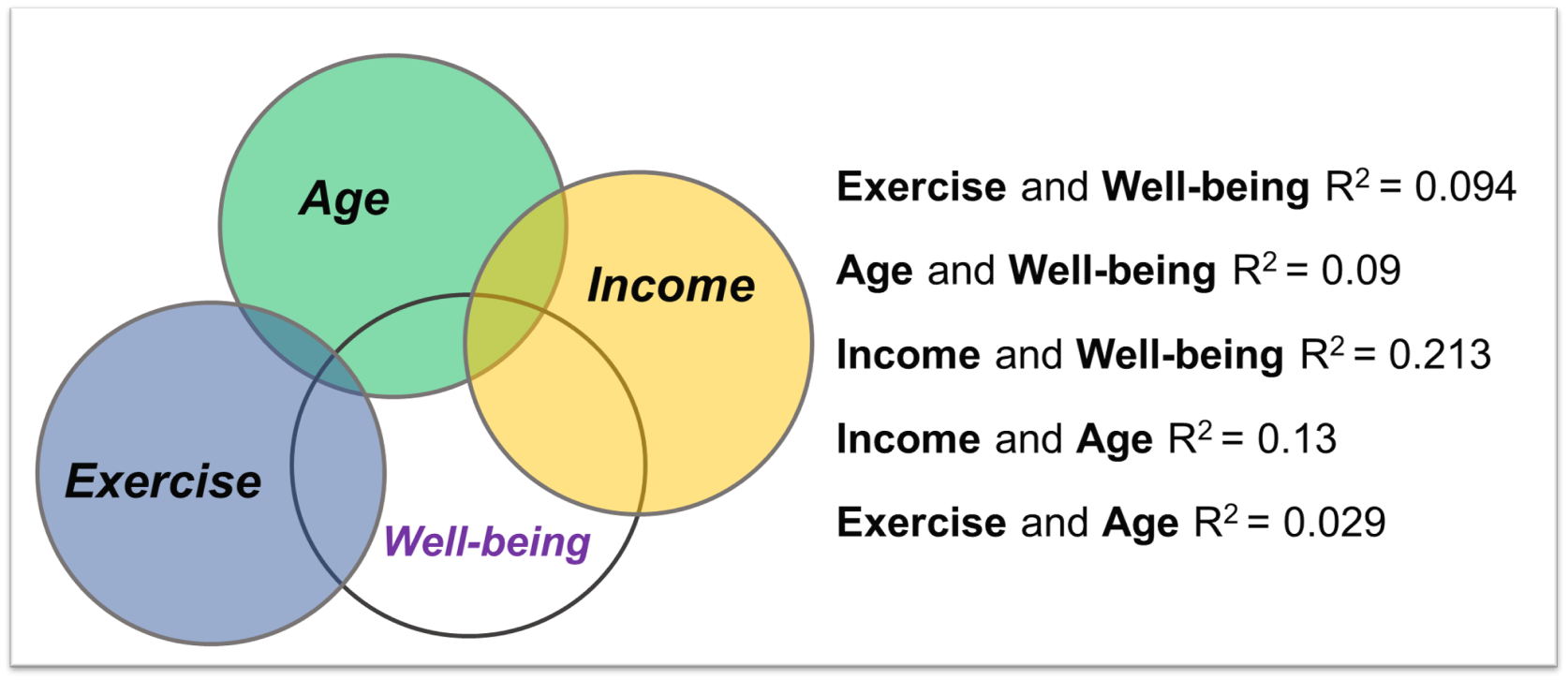16 Multiple regression
Multiple regression is a method that helps us predict an outcome variable based on several independent variables. It is a technique that tells us which variables are the most important for predicting an outcome, and how such predictor variables interact. By building a prediction model, multiple regression allows us to understand how variables are connected and helps us make powerful data-informed decisions.
16.2 The Regression Equation
As you've probably realised, using Venn diagrams to illustrate the relationships among multiple variables can get quite confusing, especially when there are numerous variables that all have some degree of correlation with each other. That's where the regression equation comes in handy.
The regression equation is a mathematical representation of the relationships among the variables in a multiple regression analysis. It shows how the dependent variable is predicted by the independent variables. In its abstract form, the regression equation can be written as:
\[ y = \beta_0 + \beta_1x_1 + \beta_2x_2 + \ldots + \beta_kx_k + \varepsilon \]
Here, \(y\) is the dependent variable, \(x_1\), \(x_2\),...,\(x_k\) are the independent variables (i.e. the amount of exercise, age, and income of the participants), \(\beta_0\) is the intercept, \(\beta_1\), \(\beta_2\),...,\(\beta_k\) are the coefficients for the independent variables, and \(\varepsilon\) is the error term, representing the unexplained variability in the dependent variable (i.e. the left over white space in the Venn diagram figure above).
The intercept \(\beta_0\) represents the value of the dependent variable when all independent variables are zero. This \(\beta_0\) is equivalent to the intercept, \(c\), value in the equation from last week.
The coefficients (all the remaining \(\beta\) values) represent the average change in the dependent variable for a one-unit change in the respective independent variable, holding all other variables constant. Just like the gradient of the line \(m\) value in the equation from last week. The "..." and the \(k\)'s are just a way of saying "add in as many beta values as you have variables in your model".
Running our regression analysis allowed us to substitute numbers for all of the coefficients to the degree that all we are left with are \(x\)'s, that we can use to sub in our data.
16.3 Interpreting a regression model
I will explain the steps for running a regression model, in full, in this weeks JASP workshop. For now, I want us just to focus on the interpretation. Here is the JASP output for a model that uses the variables exercise, age and income to predict well-being scores.
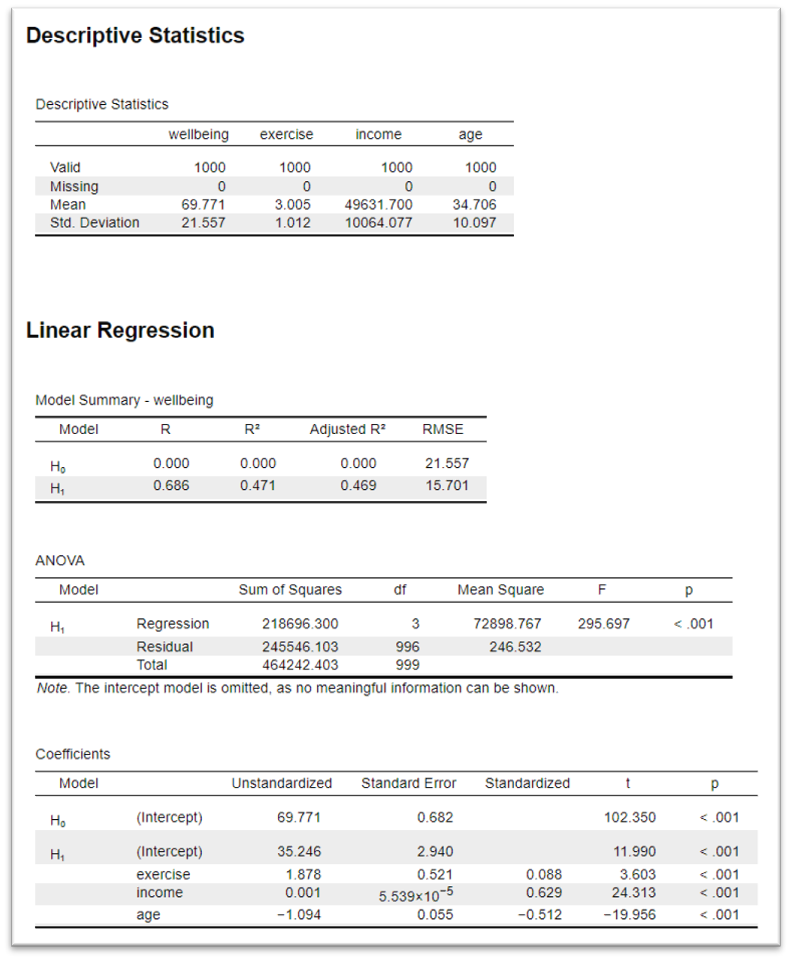
Let's break this down by table.
16.3.1 Descriptive statistics
The descriptive statistics are useful for context. This detail isn't given here but I can tell you that in this dataset (N=1000), the well-being score is out of 100, the exercise variable is based off of number of hours of exercise a week, income is in £GBP, and age is in years.
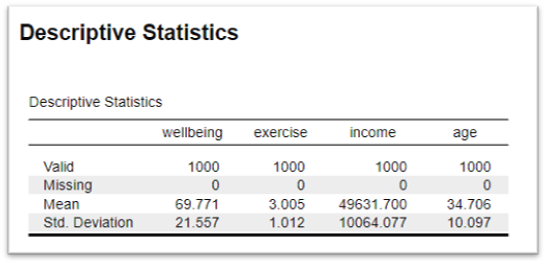
16.3.2 Model Summary
The Model Summary table provides an overview of the overall performance of the regression model. It contains key statistics that helps us assess how well the model fits the data.
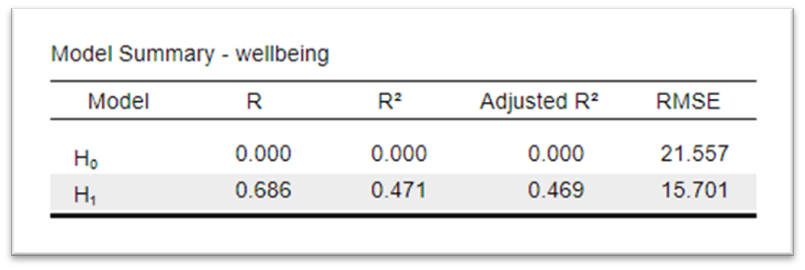
The table contains two rows \(H_0\) and \(H_1\). \(H_0\) refers to the null model, a model that assumes that none of the predictors in the model have an effect on the dependent variable, meaning that the coefficients for all predictors are equal to zero. \(H_1\) is our alternative model, the model containing our variables. This is the line that interests us.
The main details of interest are:
The Adjusted \(R^2\) Value: This is a modified version of \(R^2\) that takes into account the number of independent variables in the model. It allows us to say how much variance in our dependent variable is explained by our predictor variables.
RMSE: RMSE stands for Root Mean Square Error. It is a measure of the differences between values predicted by a model and the values actually observed. RMSE is a measure of how spread out the residuals are. In other words, it tells you how concentrated the data is around the line of best fit. It is used as our \(\varepsilon\) in the regression model.
We will often take the Adjusted \(R^2\) for multiple regression and the \(R^2\) only for simple regression (regression with just one predictor variable). For our well-being model, the Adjusted \(R^2\) of 0.469 tells us that our three variables together explain 46.9% of the variability in well-being. Which is pretty good.
16.3.3 ANOVA
The ANOVA table provides information about the overall significance of the model. It shows whether the model is better at predicting the dependent variable than a model with no independent variables (i.e., the null model).

The findings from this table will need to be reported in our write-up, however, to interpret it, all we actually need is the p-value. A significant finding on this test tells us that our model is significantly better than the null model.
ANOVA stands for ANalysis Of VAriance. We'll come back to ANOVA in week 4. For now, just think of it as a slightly fancier t-test, a test that compares across groups (rather than correlates). In this case it is comparing the null model to the alternative model and seeing if they are significantly different.
16.3.4 Coefficients
Finally, to understand the role of each variable in the model we need to look at the coefficients table.

This table provides detailed information about the individual variables in the model. It includes statistics for each independent variable and the intercept for the model.
There are two columns that are key to our understanding of the model. The Unstandardized column and the p column.
Starting with the p column, this is the probability of obtaining a t-value as extreme as the one observed if the null hypothesis is true. A small p-value indicates that the variable plays a statistically significant role in our model. It could be the case that we include a variable that is not related to our dependent variable or the variance it explains is accounted for by other variables in the model. In those cases, the p-value would be above 0.05. A p-value of <.001 for all three of our variables indicates that they are all relevant to include in our model.
The values in our Unstandardized column correspond to the \(\beta\) values in our regression equation. They play the same role as the gradient of the line of best fit from simple regression last week. They represent the absolute change in the dependent variable for a one-unit change in the independent variable, holding all other variables constant.
In our model, this table tells us that:
- For every 1 hour increase of exercise a week, well-being increases by 1.88 points.
- For every 1 year of ageing, well-being decreases by 1.09 points.
- For every £1 of income, well-being increased by 0.001 points.
That last finding is not as intuitive as it could be, so it makes sense to convert income into values of 1000's of pounds (i.e. if someone earns £32500 a year they can be said to earn 32.5 thousand pounds a year). To do this all I need to do is divide each of our income values by 1000 and run the model again.
Doing so gives us this:

- For every £1000 of income, well-being increases by 1.35 points.
16.4 Building our regression equation from the model
From this we can now start building out our regression equation. We have three variables predicting well-being so all we need to do is fill in the \(\beta\) values and the \(\varepsilon\) in the following equation.
\[ Wellbeing = \beta_0 + \beta_1income + \beta_2age + \beta_3exercise + \varepsilon \]
\(\beta_0\) = The unstandardized (beta) value for the intercept of \(H_1\) = 35.25
\(\beta_1\) - \(\beta_3\) = the unstandardized (beta) value of the three variables = 1.35, -1.09 and 1.88
\(\varepsilon\) = the Root Mean Square Error (RMSE) of \(H_1\) = 15.7
This gives us the following regression equation:
\[ Wellbeing = 35.25 + 1.35income -1.09age + 1.88exercise + 15.7\]
From this equation, if we knew an individual's income, age and how much exercise they engaged in per week we could estimate their well-being with a fairly high degree of accuracy.
Alongside the equation it is important to note our Adjusted \(R^2\) of 0.469, and indicate that this means that over half of the variability in well-being is not explained by the variables we have included in the model.
16.5 So what?
What is the point of doing all this work? Well, if I'm wanting to increase the well-being of my local community this finding might put me off putting money into community exercise classes. While there all likely other benefits of such an intervention, there are only so many hours in a week and, based on this data, a 1.88 point increase in well-being (on a scale out of 100) for an extra hour of exercise might not be the most cost-effective way of spending my limited pool of money.
Then again, it's not like we can stop someone from ageing, or increase their income. Perhaps further research that compares the effects of, for example, exercise, mindfulness and diet, while controlling for demographic factors, would be useful to inform what type of intervention might be more cost-effective.
16.6 Week 2 - Test yourself mcq’s
- What is multiple regression?
- What is the regression equation?
- In the regression equation, what do the β values represent?
- What do the values in the Unstandardized column in the coefficients table represent?
- What does the Adjusted \(R^2\) value tell us in a multiple regression analysis?

